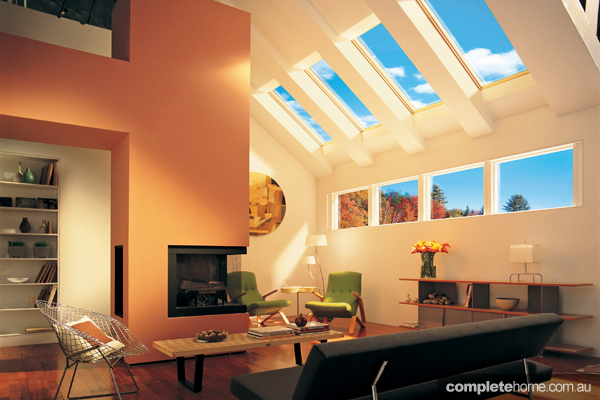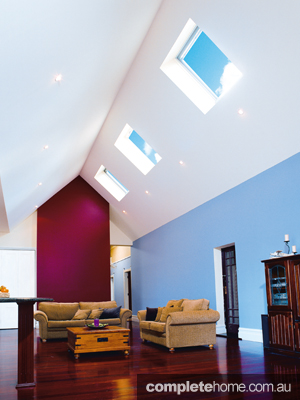Make use of our greatest asset, the big light in the sky.
The benefits of natural light are backed by masses of scientific research. “Natural sunlight provides us with a number of benefits for both our mental health and physical wellbeing,” explained Zoe Given-Wilson, Clinical Studies Officer for the Institute of Psychiatry, UK. Zoe goes on to explain that our bodies use the sunlight to produce a number of different chemicals in the brain, including melatonin and serotonin and, in turn, these assist our biorhythms (sleep patterns), immune systems, and some scientists have found links to a reduction in heart problems.
Aside from the facts, though, there is no debate that a bright sunshiny day just makes you want to get up and get into life, which is one of the reasons why our homes are continuing to open up to the elements. However, four glass walls are not an option for everyone, nor particularly appealing if you live away from a secluded cliff, so skylights, roof windows and highlights are a popular option — as archicentre has explained on the previous two pages.
It really comes as no surprise that the demand for more light is one of the most common requests heard by architects. Finally we are wising up and tapping into the strengths of the Australian climate. The benefit, aside from the obvious introduction of a clean and crisp natural light, is the potential to displace much of the electrical lighting during the day. The Skylight Industry Association (SIA) states on its website, “It has long been recognised that daylight is an excellent source of ‘cool light’, meaning a given amount of light is accompanied by less heat gain than almost any type of artificial light.”
Better distribution of light
In electric lighting design, most of the light is directed downwards toward tabletops and work surfaces. Horizontal surfaces are therefore more brightly illuminated than vertical surfaces. In contrast, daylight is a diffused source of light and tends to more evenly illuminate surfaces in all directions — up, down and sideways.
Better colour rendition
In the daylight, colours tend to look more vivid; daylight includes a continuous spectrum of light wavelengths, whereas most electric sources are strong in some areas of the spectrum and weak in others. Therefore, daylight renders all colours well and in tones that we tend to consider the most “natural”.
When it comes to skylights, the options are many and varied — shape, size, glazing, frames … the list goes on. Thankfully, Robert Cussigh, President of The Skylight Industry Association, made a little time in his busy schedule to answer some questions.
Q. What are people generally trying to achieve when they install a skylight?
A. “Obviously to bring light in, but more and more to add a wow factor. To create a light and open feel to a room and create a comfortable living environment. The room becomes inviting and is no longer dark and dingy.”
Q. What should people think about before they race off to get skylights?
A. “They need to consider what they are trying to achieve. Is it purely light, or light and ventilation? Are they chasing the wow factor to create a statement and add value to their home? Or is it simply for tasks, like being able to see what clothes are in the cupboard?”
Q. Why would people opt for transparent versus translucent glazing?
A. Most would choose transparent to get the outside view. You may live in a rural area where you have the view of surrounding trees etc through the transparent glazing.
Q. There are many sizes and shapes available. How does someone choose the percentage of skylight to roof ratio?
A. This question is a little more difficult to answer. Size will vary from product to product and is widely dependant on the size of the lightshaft used. The orientation on the roof also plays a part (facing north, south, east, west); however, as a general rule, you would use a skylight of approximately 800mm x 800mm to do a 3m x 3m room. In most instances this would create enough light.
Q. Are there other aspects to consider when installing the roof windows — such as north facing or a certain pitch of roof?
Again, this is dependent on the product. For north facing you should choose a skylight with a good energy rating to get maximum light with minimum heat gain.
FOR MORE INFORMATION
Skylight Industry Association
Your Home
Originally from Home Renovation Ideas magazine, Volume 1










